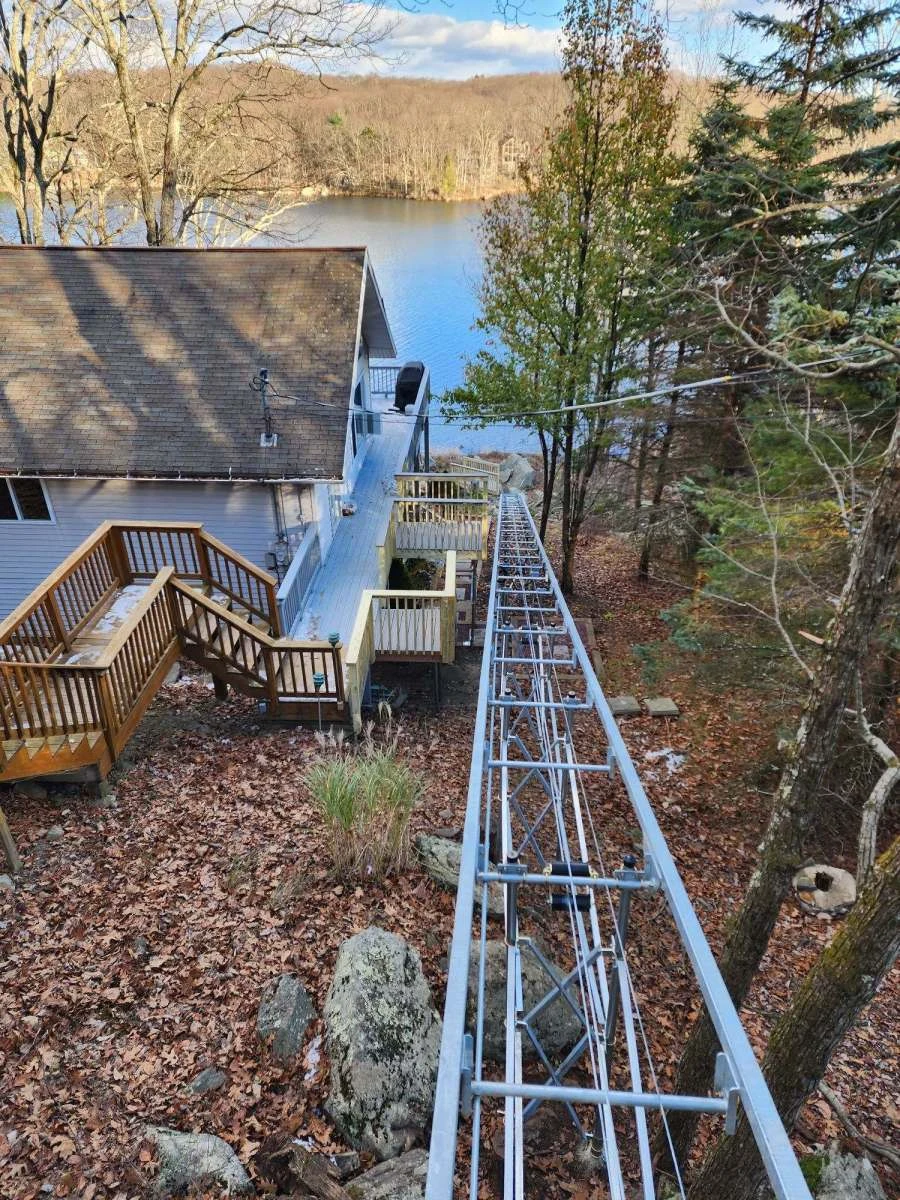FAQs about Elevator Lifts
- TELL ME ABOUT THE RAIL AND HOW IT’S ANCHORED
The proper footing system is extremely important to guarantee a safe installation, which is why an onsite evaluation and using the proper material is crucial. We recognize the
importance of understanding the soil conditions of your property. Our representatives will analyze your specific needs and a footing system for your incline elevator will be planned accordingly.
Hillside Lifts uses 2” galvanized WT40 pipe for your footing system which is a high alloy steel and is the best in the industry. If working in sand, gravel or clay, the installation crew will drive your supports at least 7 to 12 feet down with a hydraulic pounder or until the required resistance is obtained. Our process of driving the pilings into the earth has very little or no impact on your hill, landscaping or environment, yet still provides the most secure structural system.
In rocky conditions, we will drill directly into the rock per engineered standards and set the supports in anchoring cement.
If there is additional cross bracing needed for uneven terrain, we will clamp around the structure using high grade u-bolts, which is preferred over drilling directly into the supports which may weaken the support system and allow corrosion to start.
Our hillside rail system is made of either 3”x3” or 2”x5” galvanized or powder-coated 11 gauge enclosed steel tubing depending on the specifications of your hillside. A c-channel rail system is not used since it allows for debris to build up inside the track. Our rail system can be flexible to work with all types of hillside’s and gives us the ability to contour to the gradient of the hill. Also the depth of our track system allows the cable to be suspended above the track and cross members to prevent cable wear. - WHAT WOULD HAPPEN IF THE CABLE BREAKS?
Our traction drive system uses galvanized 5/16” cable that has a 9,800 lb. breaking strength and our drum drive units use 1/4” cable with a 7,000 lb. breaking strength. This type of cable is commercial grade and is used in the aircraft industry as well as for many other applications. It is virtually impossible for this type of cable to break in the application we are using it for.
You will have peace of mind knowing that if an over-speed is detected for any given reason while traveling downhill, our carriage will immediately come to a smooth, slow stop because of the over speed governor and spring dampeners we use to absorb the shock. - IS A 3 HP MOTOR ADEQUATE?
In most situations, yes, a 3 hp motor is more than adequate. In certain situations where the length, weight capacity or angle are to a higher degree, a larger motor may be necessary. Our tram systems have all been designed and engineered to meet the required safety factors. Once you receive an estimate, it will list the size motor that is sufficient for your project. If you prefer a larger motor size, that upgrade is available, but not usually necessary or required.
- WHAT MAKES YOUR INCLINE ELEVATOR SAFE?
Hillside Lifts elevators meet or exceed the most current National Elevator Codes. Our systems include top and bottom landing controls which feature e-stop buttons.
Safety switches are included on our braking system which have endless advantages and are necessary for code compliancy. We also have a battery powered wireless technology and a
supervised signal that is a crucial component in the safety of your incline elevator. This means that your system will not operate if your carriage doors are open, which is an extra safety precaution, especially for small children.
Lastly, our incline elevators have multiple safety systems which include a slack cable switch on the hoist cable, electronic safety brake switch, and an over speed governor used to initiate a mechanical stop. - CAN MY CARRIAGE FALL OFF THE TRACK?
Our specifically designed carriage rides on top of the track. The wheels are exactly formed to contour perfectly around both sides of the track for guidance. Solid track guides are mounted on the wheel housings and then around the track to keep the carriage in place. These two design elements absolutely will not allow for any horizontal or vertical movement off of the rail system.
The wheels are also enclosed by wheel housings. This is beneficial so debris, branches, snow, etc. is unable to obstruct the carriage wheels which would cause uneven wear. It is important for the wheels to ride on top of the rail as it allows for easy access to inspect, maintain and lubricate each one of the wheels during your annual safety inspections. - DRUM DRIVE VS. TRACTION DRIVE….WHAT’S THE DIFFERENCE?
We specialize in both traction drive and drum drive power units. Each is used in specific applications to increase efficiency. In a drum drive application, the cable is wound around a drum that winds and unwinds as the carriage travels up and down. We will go up to 160 feet with a drum drive system. With a track length over 160 feet, the drum diameter becomes big and bulky and a larger motor and gearbox is required to drive the system or a large cover or pit is necessary. This set up would not be efficient and would also allow the cable to lie in the track and cause wear.
Our traction drive power unit is utilized on hillsides over 160 feet. The cable is attached to the top and bottom sides of the trolley and the traction sheaves move the cable up and down. This system has no length limit. The carriage and trolley are pulled down towards the bottom of the hillside and will not rely on gravity to move it like the drum drive does. - CAN I RIDE IN THE WINTER?
Yes. The owner’s manual that you will be provided gives you instructions on winter use.
The recommended operational temperature ranges from 0 – 110 Degrees Fahrenheit. - WHO WILL INSTALL MY LIFT?
The installation process is equally important to the overall quality, which is why Hillside Lifts takes complete action in making sure every single installation is done just as it should be to keep you and your family safe. Your incline elevator will be installed by only factory trained and certified installers.
- DO YOU OFFER SERVICE?
Service is Key. Not only do we offer a great warranty, but we also employ a full-time service staff that is available for general questions and service calls. Having certified service technicians on staff sets us apart from other tram companies.
You will choose an “every year” or “every other year” maintenance plan. Our technicians travel throughout the year completing these inspections and safety tests for a minimal fee to make certain that your system is running smoothly and safely year after year. We will take care of you and your lift long after your installation is complete.Hillside Lifts offers the following warranty:
2 year comprehensive warranty on all parts and components
5 years on the motor, gearbox and brakes
20 years on the structure and pipe footings - IS A TRAM RIGHT FOR MY HILL?
We have a lot invested in the design and engineering of our hillside lifts. We also have many years of experience on knowing how to complete an entire site evaluation and layout of your hillside as well as provide you with options and step-by-step details of our installation process. We guarantee that you will be getting exactly what you are expecting and more which is why the site evaluation and layout is extremely important. The site is analyzed so we can decide which one of our incline elevator systems will meet the defined specifications of your hill. After the site visit, Hillside Lifts will provide you with an estimate for all materials and installation expenses that are needed for your installation.
- DO I NEED A PERMIT?
Hillside Lifts will assist each customer individually on their specific state and local permit requirements. We know that permitting can be overwhelming for homeowners, which is why we provide engineered drawings and any other details that are necessary for permit approvals. We will work together to make the process worry free. Once the installation is complete, Hillside Lifts will arrange for the final inspections with state and/or local officials, where applicable, in order to close the permits.
- WHAT ARE LANDING GATES?
Landing gates are the gates that are fixed to your upper and lower landing platforms or decks. Their purpose is to block the opening when the tram cart is called to the opposite landing. These gates are required by the elevator code and are necessary to pass the State inspection, where applicable. Landing safety gates are included in the cost of your overall system. Platforms can be constructed by the homeowner after the tram installation is completed or can be done by Hillside Lifts out of either aluminum, composite or pressure-treated lumber. If you choose to build your own landings, Hillside Lifts will supply you with the required or suggested specifications. If you choose to have Hillside Lifts take care of them, we will work with each homeowner individually on the preferred size and building material and will be built to elevator code specifications.

